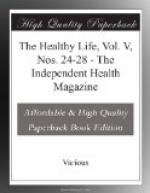for judging the utilisation of an ingested albumin
lies in the persistence of the corporal weight, allied
to the ascertained fact of a stable equilibrium in
the total azotized balance-sheet which is provided
by the comparison of the “Ingesta” with
the “Excreta.” From this point of
view there exists the closest similitude between
the albumins of animal and those of vegetable origin;
both, in fact, are capable of assuring good health
and corporal and cellular equilibrium.
However, the digestibility of vegetable albumins seems to remain slightly inferior to that of animal albumins. 97 per cent. of the animal fibrine given in a meal are digested, where 88 to 90 per cent. only of vegetable albumins are absorbed and utilised. It is a small difference, but not one to be overlooked. We must say, however, that the method one employs in determining these digestibilities takes from them a part of their value, and renders difficult the comparison of results obtained. Sensibly pure albumins are too often compared in an artificial diet. One deviates thus from the conditions of practical physiology. In fact, in ordinary meals, all varieties of foods are mixed together, acting and reacting upon each other, reciprocally modifying their digestibility. If one conforms to this way of acting towards alimentary albumins, the results change sensibly. In the presence of an excess of starch, under the shape of bread, for example, vegetable albumin seems to be absorbed in about the same proportions as animal albumin.
If, in a flesh diet, animal albumins are always consumed nearly pure (lean meat containing hardly anything but albumin, besides a little fat, and an inferior quantity of glycogen) vegetable albumin is always, on the contrary, mixed with a number of other substances. This is doubtless one of the reasons which causes the digestibility of vegetable albumins to vary, the foreign nutritive matters being able to bring about, under certain circumstances, and in cases of superabundant ingestions, a real albuminous “saving” in the newest sense of the word.
Besides, a prejudicial question makes the debate almost vain. When it was admitted by such physiologists as Voit, Rubner and their school that from 140 to 150 grammes of albumin in the minimum were daily necessaries in the human diet, a variation of a few units in the digestive power presented some importance. Nowadays the real utility of albumins is differently appreciated. The need of them seems to have been singularly exaggerated; first lowered to about 75 gr. by A. Gautier, it has dropped successively with Lapicque, Chittenden, Landergreen, Morchoisne and Labbe, by virtue of considerations both ethnological and physiological, to 50 grs., 30 grs. and even to 25 or 20 grammes. The “nutritive relation”—that is to say, the yield from albuminoid matters to the total nutritive matters of diet—is thus brought down from 1/3 its primitive value to 1/15




